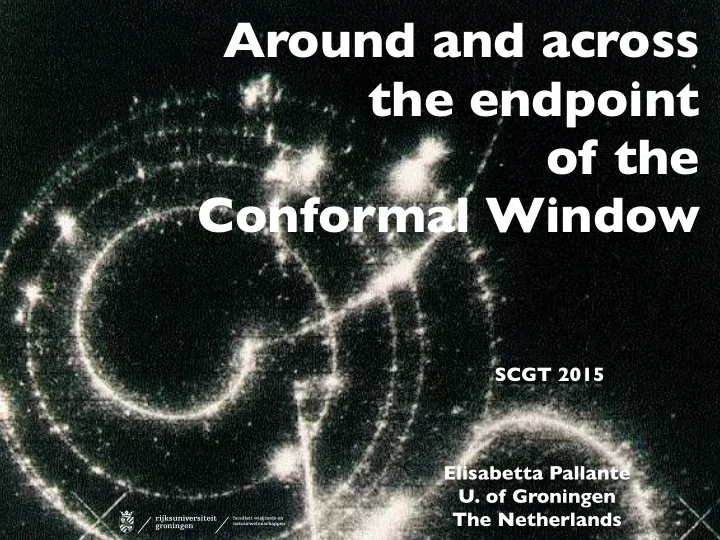

Around and across the endpoint of the Conformal Window SCGT 2015 Elisabetta Pallante U. of Groningen The Netherlands
Outline ‣ The energy flow ‣ Topology ‣ The spectrum
Phase diagram: T -N f plane T QGP c asymptotic h Phase i r a l freedom lost p transition h a s e b o u n d a r y conformal window N f
The energy flow
Wilson flow (modified) Perturbation theory close to trivial UVFP [Luscher 2010] Wilson flow “time” t • It does not need renormalisation (NLO in perturbation theory at least) • Residual “t” dependence due to breaking of conformal symmetry
Larger Wilson flow time/beyond perturbation theory Confining IRFP Trace anomaly constrains this anomalous dimension
Trace anomaly of QCD Scaling of a quantum operator Non renormalization of implies IRFP
Illustration of method on the lattice �� �� bulk PT line �� � Fixed coupling varying Nf � � �� �� �� �� � � ��� ��� ��� ��� � ��� ����
w L. Robroek P R E L I M I N A R Y ������������������������� � �������������������� � ���������������� � N f = 8 ��� ��� ��� ��� ���� ��� ���� ��� � � ��� � ��� ��� N f = 9 ��� N f = 10 ��� N f = 11 � � � � � � �� ������������� ...and do not use this figure to decide where the endpoint lies
w L. Robroek P R E L I M I N A R Y ������������������������������ � ����������������������������� � ���������������� � ��� ��� ��� ���� � ���� ������ � ������������ ��� � ��� � ���� � � � � � �� �������������
Nf=8 and 12 configurations by Lombardo, Miura, Nunes, EP 2013, 2014 not averaged w L. Robroek
Anomalous dimension in perturbation theory [ Ritbergen Vermaseren Larin 1997]
Topology (and the U(1) axial anomaly)
3 symmetries play a role at the endpoint • Conformal symmetry • Chiral (flavour) symmetry • U(1) axial How many order parameters ?
Topological charge and susceptibility /winding number second moment of Q distribution The U(1) axial anomaly • N f = 0 Axial current conserved for relevant for AdS/CFT • N c = ∞ arguments
The effective restoration of the U(1) axial symmetry [see also: Deuzeman, Lombardo, EP 2010 Lombardo, Miura, Nunes, EP 2012, 13] N f > 2, T > T c QCD shares a lot with Conformal Window One difference: ∃ IRFP For N f > 2 there is one relevant order parameter Chiral condensate U(1) axial order parameter (irrelevant for IRFP physics)
It suggests one single phase transition for chiral and U(1) axial (effective) restoration ⇒ sharp change in topological susceptibility [e.g. Del Debbio, Panagopoulos, Vicari 2004 T>Tc ~ sharp change in instanton distribution Parnachev&Zhitnitsky, Zhitnitsky 2013 CW Reverse ‘t Hooft argument: Restored U(1) axial means the absence/suppression of instantons, which carry topological charge. If we suppress instantons, GG essentially vanishes. ∼ This effect may be sharper than at finite T (due to existence of IRFP)
Illustration: Wilson flow of topological charge ��������������������������� � ���������������� ���������������������������� � ���������������� �� � ��� ���� � �� � � � � � � �� � �� �� �� �� ��� �� � � � � � �� � � � � � �� ������������� ������������� N f =8 N f =11 Rough: plausibly large lattice spacing effects in addition to broken chiral symmetry
Dirac operator zero modes Atiyah-Singer Index Theorem Q ≠ 0 from zero modes ( χ s = ± 1) Banks-Casher Vanishing chiral condensate implies ρ (0)=0, and does not contradict Q=0. It still agrees with exponential suppression of topological susceptibility. However, no evident distinction between N f =2 and N f >2.
2-point functions [inspired by old work by Lagae, Kogut, Sinclair 1998 see also Deuzeman, Lombardo, Nunes da Silva, EP 2011, and later] Assume exact chiral symmetry: do spectral decomposition disconnected N f > 2: degeneracy under SU(N f ) and U A (1) implies the absence of contributions from nonzero topological charge sectors.
Possible scenario
Endpoint conformal window ⇔ Restoration of SU(N f ) and U(1) axial ⇔ (at least) exponential suppression of topological susceptibility (i.e. instanton distribution) ⇓ Absence of nontrivial topological charge
The spectrum
IRFP with mass deformation S i l v a , E P 2 0 1 4 ] L o m b a r d o , M i u r a , N u n e s d a [ What happens just below the endpoint ? N f = 12, γ m ~ 0.25
Even possible inversion of π - σ states at m > 0 a 1 1 ! 0.8 π aM H 0.6 CPT scaling " 0.4 enters GMOR 0.2 0 0 0.01 0.02 0.03 0.04 0.05 0.06 am If Conformal Phase Transition is realised, then a smooth variation of the dynamically generated mass scale leaves its footprint in the spectrum Plausible is that the scalar state is not parametrically lighter. Why?
• Pions only Goldstone bosons • Conformal symmetry explicitly broken at CPT • Broken chiral symmetry implies • This system smoothly flows into QCD [see also AdS/CFT: Kutasov, Lin, Parnachev 2012]
Summary • Energy flow, topology and spectrum carry important footprints of the endpoint dynamics • Interplay of 3 symmetries: conformal, chiral and U(1) axial • One difference with N f >2, T >T c : existence of IRFP . Analogy with quantum critical phenomena more natural than a first order phase transition driven by instabilities • Chiral and U(1) axial effective restoration at the endpoint associated to (at least) exponential suppression of topological susceptibility (instantons) and absence of zero modes • Possible π - σ inversion at finite fermion mass, with no dilaton
Backup slide
�� �� bulk PT line �� � Fixed coupling varying Nf � � �� �� �� �� � � ��� ��� ��� ��� � ��� ���� Possible separation between 2 chirally broken phases Nf dependence effectively suppressed.
Recommend
More recommend